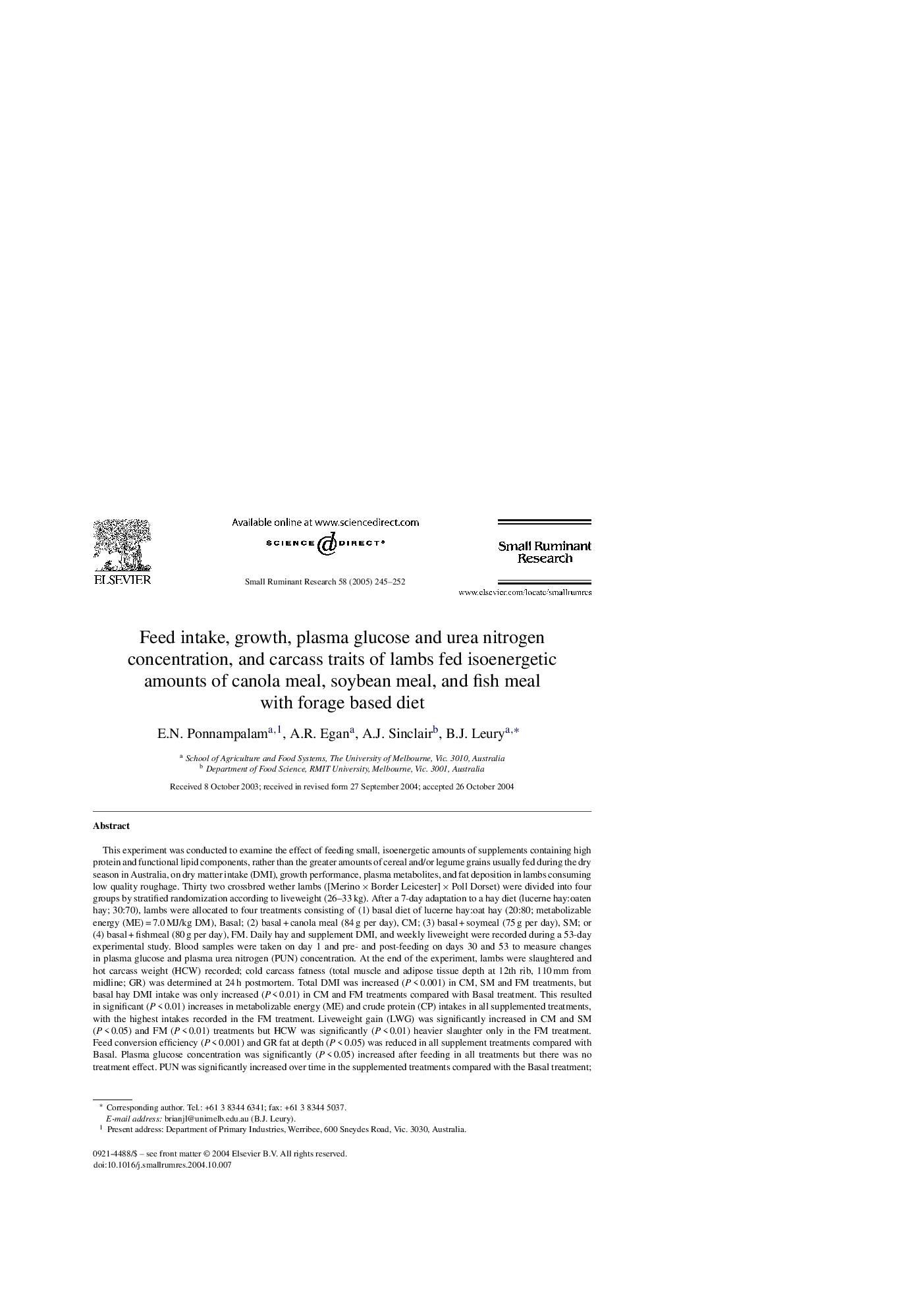| کد مقاله | کد نشریه | سال انتشار | مقاله انگلیسی | نسخه تمام متن |
|---|---|---|---|---|
| 8987039 | 1110784 | 2005 | 8 صفحه PDF | دانلود رایگان |
عنوان انگلیسی مقاله ISI
Feed intake, growth, plasma glucose and urea nitrogen concentration, and carcass traits of lambs fed isoenergetic amounts of canola meal, soybean meal, and fish meal with forage based diet
دانلود مقاله + سفارش ترجمه
دانلود مقاله ISI انگلیسی
رایگان برای ایرانیان
کلمات کلیدی
موضوعات مرتبط
علوم زیستی و بیوفناوری
علوم کشاورزی و بیولوژیک
علوم دامی و جانورشناسی
پیش نمایش صفحه اول مقاله

چکیده انگلیسی
This experiment was conducted to examine the effect of feeding small, isoenergetic amounts of supplements containing high protein and functional lipid components, rather than the greater amounts of cereal and/or legume grains usually fed during the dry season in Australia, on dry matter intake (DMI), growth performance, plasma metabolites, and fat deposition in lambs consuming low quality roughage. Thirty two crossbred wether lambs ([Merino Ã Border Leicester] Ã Poll Dorset) were divided into four groups by stratified randomization according to liveweight (26-33 kg). After a 7-day adaptation to a hay diet (lucerne hay:oaten hay; 30:70), lambs were allocated to four treatments consisting of (1) basal diet of lucerne hay:oat hay (20:80; metabolizable energy (ME) = 7.0 MJ/kg DM), Basal; (2) basal + canola meal (84 g per day), CM; (3) basal + soymeal (75 g per day), SM; or (4) basal + fishmeal (80 g per day), FM. Daily hay and supplement DMI, and weekly liveweight were recorded during a 53-day experimental study. Blood samples were taken on day 1 and pre- and post-feeding on days 30 and 53 to measure changes in plasma glucose and plasma urea nitrogen (PUN) concentration. At the end of the experiment, lambs were slaughtered and hot carcass weight (HCW) recorded; cold carcass fatness (total muscle and adipose tissue depth at 12th rib, 110 mm from midline; GR) was determined at 24 h postmortem. Total DMI was increased (P < 0.001) in CM, SM and FM treatments, but basal hay DMI intake was only increased (P < 0.01) in CM and FM treatments compared with Basal treatment. This resulted in significant (P < 0.01) increases in metabolizable energy (ME) and crude protein (CP) intakes in all supplemented treatments, with the highest intakes recorded in the FM treatment. Liveweight gain (LWG) was significantly increased in CM and SM (P < 0.05) and FM (P < 0.01) treatments but HCW was significantly (P < 0.01) heavier slaughter only in the FM treatment. Feed conversion efficiency (P < 0.001) and GR fat at depth (P < 0.05) was reduced in all supplement treatments compared with Basal. Plasma glucose concentration was significantly (P < 0.05) increased after feeding in all treatments but there was no treatment effect. PUN was significantly increased over time in the supplemented treatments compared with the Basal treatment; there was no significant difference between supplement treatments by day 53. Results show that feeding small amounts of high protein and lipid-containing supplements improves production responses and are beneficial in producing carcasses with more lean compared with carcasses from lambs fed a low quality hay diet.
ناشر
Database: Elsevier - ScienceDirect (ساینس دایرکت)
Journal: Small Ruminant Research - Volume 58, Issue 3, June 2005, Pages 245-252
Journal: Small Ruminant Research - Volume 58, Issue 3, June 2005, Pages 245-252
نویسندگان
E.N. Ponnampalam, A.R. Egan, A.J. Sinclair, B.J. Leury,